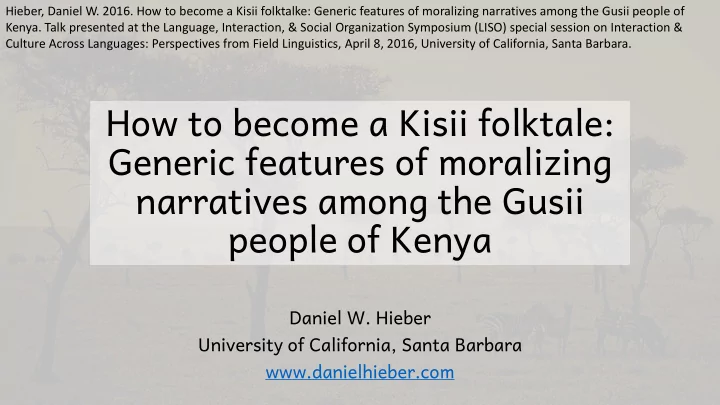

Hieber, Daniel W. 2016. How to become a Kisii folktalke: Generic features of moralizing narratives among the Gusii people of Kenya. Talk presented at the Language, Interaction, & Social Organization Symposium (LISO) special session on Interaction & Culture Across Languages: Perspectives from Field Linguistics, April 8, 2016, University of California, Santa Barbara. How to become a Kisii folktale: Generic features of moralizing narratives among the Gusii people of Kenya Daniel W. Hieber University of California, Santa Barbara www.danielhieber.com
Generic features of Kisii folktales Minimizing intertextual gaps • Constructed as traditional / ancient • Invoke moralizing characters • Downplaying the self •
Example 1: Okang’ɔmbe, Ogansona, n’Okanda (Kennedy Bosire) Cow, Flea, & Jigger mogano ngôôchá înde May I, Story, come? karɛ Long ago, karɛ karɛ karɛ long, long, long ago, ɔ́kang’ɔmbɛ́ Cow, no: and ôgansoná Flea n ’ ôkandá and Jigger bikagɛnda ɔ́bɔkɔ set out to their in-laws.
Example 2: Omoiseke osookerete chiseese (Helen Makana) A girl who got married to dogs mogano ngôôchá înde May I, Story, come? mogano închûó Story, come. ômoîsêké A girl n ’ âarɛ́ngɛ́ was there ɔ́sɔɔkɛ́rɛ́tɛ́ chîsɛ́ɛsɛ́ who was married to dogs. ômoîsêké ôyo This girl, ɛ́kɛrɔ́ asɔɔkɛ́rá chîsɛ́ɛsɛ́ when she got married to dogs, tâatâgete âbaîbôrí bâyɛ she didn’t want her parents to bagɛnda ɔ́rɔrɔ go there.
Example 3: Okando n’Okanyang’au (Helen Makana) Lion and Hyena mogano ngôôchá înde May I, Story, come? mogano închûó Story, come. êndo y'âarɛngɛ́ There was a lion n'ênyangʼaaú and a hyena. êndo êye îgo yâare kɔ́gɛnda This lion used to go and plant, y'ââsîmêká chînchûgú ground nuts.
Example 4: Abaana batano banyorete chinkenene (Helen Makana) Five girls go picking mulberries mogano ngôôchá înde May I, Story, come? mogano închûó Story, come. âbââná bâarɛ́ngɛ́ bâtânɔ There were fjve children. âbââná âba bâtânɔ These fjve children, bakagɛnda gotwá chînkɛnɛnɛ they went to pick mulberries. ɛ́kɛrɔ́ bââchîá gôtwá chînkɛnɛnɛ When they went to pick mulberries, they reached there where the bagaîká igá ariâ âasé chînkɛnɛnɛ mulberries were, bakamânyá kɔ́nyɔ́ɔ́rá chînkɛnɛnɛ they found that the mulberries chiriá êchîré chîmbese were not ripe. bagachââká îngôtênya bâarɛngɛ They started fetching fjrewood. bagatênyá
Minimizing Intertextual Gaps • length (3-5 minutes) • opening call-and-response • exaggerated prosody • reference to (and reliance on) characters that appear in other stories • story structure (introduction of characters) • linguistic features (anthropomorphic prefix) • songs as plot devices
Constructing Tradition & Authority lexical / grammatical means ( karɛ ‘long ago’; far past tense) • references to items and customs from historical Gusii society • avoidance of references to modern items •
Invocation of Moralizing Characters anthropomorphizing prefjx • characters have a large intertextual reach • create a set of expectations as to how characters will behave • this expectation allows listeners to interpret the character ’s actions •
Downplaying the Role of the Narrator personifjcation of the story • use of fjrst person when talking about the story • vocative form of ‘story’ • strict avoidance of fjrst -person statements or • metacommentary strict avoidance of self -correction (only restarts are used for • repairs) focus on proper performance (breathing, full repetition of • songs, exaggerated prosody)
Conclusion • Text-as-object: Emphasizes relationship between audience and larger set of cultural norms and traditions • Strategies for emphasizing text-as-object: • minimizing intertextual gaps • frame stories in the distant past to imbue them with authority • invoke culturally-recognized characters that index certain moral stances • engage in a process of self-erasure • In emphasizing the text as a highly entextualized, reified cultural object, speakers accomplish the more fundamental task of social action.
Recommend
More recommend